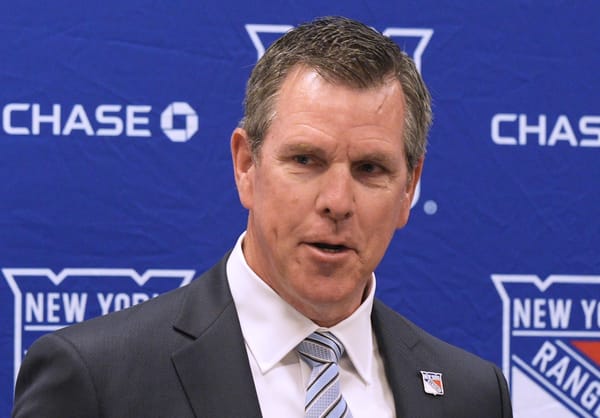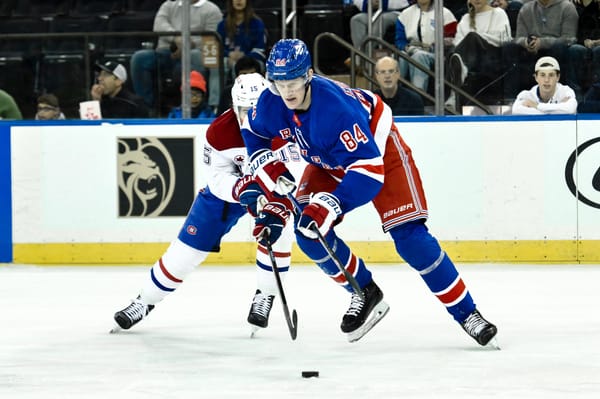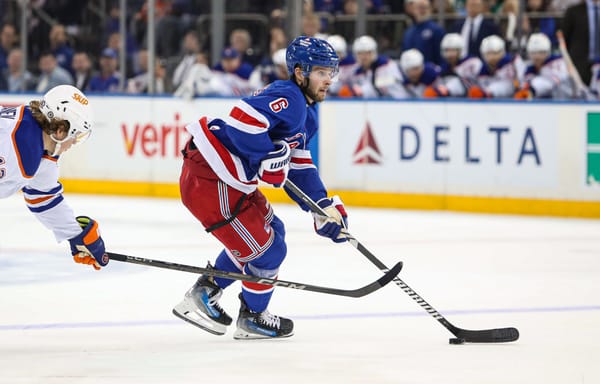What If The New York Rangers Just Bought Out Marc Staal?
It is unlikely, but it would be a good first step in figuring out future financial landscape.
A lot has been made of the New York Rangers salary cap crunch. Mike eloquently went into this topic earlier this month after free agency began. With 21 players under contract, $7,093,534 in cap space, and four restricted free agents in Trouba, Buchnevich, Tony DeAngelo, and Brendan Lemieux to sign, a path has to be cleared to move forward.
With Jacob Trouba’s arbitration hearing a week a way, and Pavel Buchnevich’s four days after that, time is of the essence to create cap space. At this point, it was thought that there would have been at least one domino to fall, but that hasn’t been the case. As a result, there may be some concern that the Rangers could hurt their roster — whether it be taking a lesser return or having to give up a sweetener — in order to become cap compliant.
The Rangers have been able to slow walk it a bit, with time between July 1 and their first scheduled arbitration hearing. The idea is to clear space before signing Trouba and Buchnevich, since there isn’t even enough space for both of them as it stands. Once both sign, the Rangers will be in more of a bind than they are now, and that lessens their leverage in potential trade negotiations.
So how can the Rangers clear cap space this summer? Buying out Marc Staal would be a good start.
Before people jump into the comments and say, “that’s not going to happen, why are you wasting your breath...”,
A.) Just because it isn’t likely doesn’t mean it shouldn’t happen
B.) We should be exploring all possibilities
C.) I know you are going to jump into the comments anyway
D.) I have a whole rest of the story for ya’ll to read
Financially it makes the most sense. From a performance standpoint it makes even more sense. I said all I needed to say about Staal from a playing standpoint in his report card, and you can check that out here. And while I understand from a positional standpoint he’s a LHD, something team doesn’t have a lot of, I don’t think it matters all that much.
And it all goes without saying, my criticisms of Staal take into context that his effectiveness has been impacted by injuries and age. It isn’t 100 percent his fault, but tough decisions need to be made, and this is one of them. So, no; I don’t hate Marc Staal, and I am not irrationally stanning for Shatty.
While his salary is $5 million this season, and $4.2 million next, Staal counts for $5.7 million against the cap until his contract expires. A buyout would look like this:
- 2019-20: $2.9 million against the cap | $2.8 million in savings
- 2020-21: $3.7 million against the cap | $2 million in savings
- 2021-22: $1.2 million against the cap | $1.2 million in dead space
- 2022-23: $1.2 million against the cap | $1.2 million in dead space/
From an operating perspective, Staal’s contract will lead to a smooth transition from year to year thanks to its structure. The variance from year one to two is $800,000 less in savings. From year two to three it’s a swing of $3.2 million — from $2 million in savings to assuming $1.2 million in dead space.
While it adds to the cap in a year in which his salary would have come off the books, it actually comes at a fairly convenient time since a number of expiring contracts will give them some flexibility. It should also line up with an uptick in revenue from Seattle’s expansion, as well as the signing of a new U.S. television deal.
Related
Hockey's Big Pay Day Is Coming
The structure will require the Rangers to operate within the same range year over year, and that’s a much better alternative than buying out Shattenkirk, based on how his deal is structured.
The reason a buyout on defense needs to happen is because we all saw what happen this past season by having way too many D on the roster. Based on the acquisitions made and ELCs signed, the Rangers are hoarding defensemen like Thanos did the Infinity Stones, and then some.
On the Roster
- Libor Hajek
- Brady Skjei
- Kevin Shattenkirk
- Brendan Smith
- Marc Staal/
Unsigned
- Tony DeAngelo
- Jacob Trouba/
In the Mix / Hartford
- Adam Fox
- Ryan Lindgren
- Yegor Rykov/
Ultimately something has to give, because there aren’t enough spots for all these defenders to play meaningful minutes.
I mentioned Shattenkirk above, so let’s talk about him. In 119 games, the New Rochelle native has 51 points. He posted 23 points in 46 games before getting shutdown in year one, and this past season he tallied 28 points in 73 games.
I’m not going to try to go all Bob Ross and paint you a sunny picture. Despite his shortcomings, many of which stem from his injury and subsequent recovery, there’s reason to keep him and then reevaluate options a year from now.
For what it is worth, Shattenkirk mentioned that his rehab from surgery cut into his offseason training prep for the 2019-20 season, and that’s something that legitimately could explain his slow start. And while he certainly isn’t worth his current cap hit, or providing the offense that was expected of him, he’s providing more of an overall value than Staal.
In terms of a buyout, the structure provides the Rangers temporary relief, think J.G. Wentworth, albeit not enough to get them out of the situation they are in. The problem is that it puts them in a tougher spot the year after.
- 2019-20: $1.483 million against the cap | $5.16 million in savings
- 2020-21: $6.083 million against the cap | $566,667 in savings
- 2021-22: $1.433 million against the cap | $1.433 million in dead space
- 2022-23: $1.433 million against the cap | $1.433 million in dead space/
For the sake of convenience, let’s assume a raise of $2 million for the 2020-21 season and make it an $83.5 million salary cap. That leaves $29,311,034 in space as things currently stand without doing anything, or assuming current RFAs re-signing. If you buyout Shattenkirk now, that number becomes $29,877,701.
The subtle difference is because the difference in having Shattenkirk on the roster in 2020-21 as a player versus buying him out is just $566,667. Overall, his play may not warrant something as extreme as a buyout because of the long-term implications it would have on the salary cap.
If the Rangers bought out Staal instead, they’d have 12 players signed for 2020-21 and $31,311,034 in space — but we’ll get back to that.
In the piece linked at the top of this story, Mike went through a lot of the nitty-gritty, so what could things look like in the big picture with a Staal buyout?
Let’s Look at the Big Picture
If we use the contract projections from the Evolving Wild twins as a baseline and adjust a bit, here’s what the cap number could look like after new deals.
Jacob Trouba - $7.3 million, six years (rounding up from $7,192,119)
Pavel Buchnevich - $3.1 million, two years (rounding up from $2,874,385)
Tony DeAngelo - $2.5 million, two years (rounding up from $2,235,348)
Brendan Lemieux - $1 million, two years (rounding up from $993,510)
Combined, this equals approximately $13.9 million, so that would increase the 2020-21 roster size to 16 and leave $17,411,034 in space to fill seven spots.
That group of players in the combined cap hit currently includes Kreider, Namestnikov, Ryan Strome, Jesper Fast, Boo Nieves, and Alexandar Georgiev. There’s still room for either of Kreider, Namestnikov, or Strome to be traded this offseason, but I chose to include them because I feel any trade would have the Rangers receiving only a smidgen of cap relief.
If you broke it down to amount per those seven roster spots to fill, you’re looking at spending $2.487 million per player. And just for laughs, if the Rangers were to re-sign Kreider with a cap hit of $6.75 million, the team would then have $10,661,034 for six spots, or roughly $1.7 million per player.
The math here is hypothetical and speculative, but that’s the point! Look no further than the situation the team is right now, dancing with the devil in the pale moonlight trying to unload some contracts in order to sign some more.
It’s understandable to want to free up as much space as possible right now, but there needs to be an understanding of creating flexibility now and in the future; ultimately reaching a somewhat perfect balance, as all things should be.
The key to having a Stanley Cup contender is having a balanced roster. There are key pieces at forward in place right now like Artemi Panarin (top line winger) and Mika Zibanejad (top line center, but that’s not enough. In terms of carryover kids, you’d like to think Buchnevich can provide value to the tune of 50 points. There’s hope that Filip Chytil will end up being a quality top-six center, Lias Andersson will find his way, Brett Howden will be a serviceable middle six option, and Lemieux will be a decent bottom-six winger of value.
On defense it is presumed that Trouba (top pairing defenseman) will ultimately be part of that group, and then you also have pieces like Brady Skjei who still have some time to prove their worth. In goal Igor Shesterkin represents an interesting wild card, as he could potentially being the long term answer as a No. 1 goalie, but there are no guarantees. That leaves room for Georgiev, and maybe he ends up putting up a good fight.
So while the Rangers currently have some elite talent, some very good talent, and some prospects with promise, a lot hinges on kids like Kakko, Kravtsov, Fox, and Rykov, and the next crop of prospects that includes K’Andre Miller, Nils Lundkvist and so on factor in. But they are a few years away, and the Rangers will be making roster decisions before they are in the picture.
The collective success or lack thereof of the kids will play a role in how the Rangers fill out the rest of their roster, with the goal of winning a Stanley Cup guiding the decision making process. In other words, if from this group the Rangers end up with a bonafide top-line talent out of Kakko, a good second-line winger out of Kravtsov, an average second-line center out of Chytil or Andersson etc.; they are going to go out and get what they need. As the rebuild rolls on and players develop, the Rangers are going to be more decisive as they get closer to being in a position to contend for a Stanley Cup, because they’ll have a better idea of what they’ve built around, and how to supplement that.
The Rangers are going to need other NHL players, because the roster can’t all be kids, and it remains to be seen if Kreider will part of that group too. If he isn’t going to stick around, there needs to be a plan on replacing his production, one I hope isn’t: we think the kids will take care of everything — just think back to how well that worked out initially when Derek Stepan was traded.
And while it is true that the team also has salary coming off the books on July 1, 2021 —mainly Henrik Lundqvist’s $8.5 million, and whichever of Smith, Staal, and Shattenkirk are left at that point — it could coincide with Lias Andersson, Filip Chytil, Brett Howden, Buchnevich, Lemieux, DeAngelo, Libor Hajek, and Yegor Rykov being RFAs.
Just like that, there goes some a chunk of “inherited cap space.” While I don’t expect all to still be on the roster at that point, the fact is that often times when money goes “off your books” it is reinvested in other players, so you are left with less space than you’d originally thought.
This brings us back to Marc Staal. The only way for the Rangers to rid themselves of Staal’s contract is via a buyout. Anything can happen, but I highly doubt there’s a team trading for him. In many ways buying him out can set off a chain reaction of sorts, more so than simply buying out Shattenkirk.
While there may be no interest in Shattenkirk now — which again is understandable given the current state of finances among teams — I don’t expect the same to be true next summer when Shattenkirk has one year left and is making just $2 million in actual salary. At that point, if moving him is a necessity it is fair to say that at 50 percent retention there would be somewhat of a market, even if the return was somewhat light.
How I’d Proceed with the Rangers’ Cap Crunch
So while I did a lot of talking about the future, you may be asking, how does the team first get where they need to be this year? Without making too many machinations, here’s what I’d do.
This includes:
- Marc Staal buyout
- Ryan Strome traded ($1 million salary retained) for a draft pick/non-roster asset
- Trouba ($7.3 million x 6), Buchnevich ($3.1 million x 2), DeAngelo ($2.5 million x 2), Lemieux ($1 million x 2), Lettieri ($950k x 1)
- Brendan Smith, ($3.275 million against cap) Matt Beleskey ($825,000 against cap) in the AHL
- Adam Fox, Greg McKegg, Vinni Lettieri assigned to the AHL/
This roster leaves the Rangers with Kreider and Namestnikov, and moving one or both would open up even more room. I think one would have to go so the team could have more than a roster of 21, but I didn’t want to complicate things too much. You also could use the money assigned to Lindgren and Hajek and pretend the Rangers signed a veteran NHL defender around that amount as well.
As for the long term outlook?
I think this leaves the team in decent shape, and keep the door open to move Shattenkirk next year when he has one year left on his deal. Having 21 players on the roster with no extra defender and just $68,534 in space isn’t ideal, but again; this includes Namestnikov and Kreider still.
Just for the sake of presenting the alternative, here’s the above using a Shattenkirk buyout instead.
This gives the team an extra forward and defender for 2019-20, and $1.5 million in cap space this season, but what about the long-term outlook?
The net difference between the two hypotheticals (Staal buyout vs. Shattenkirk) in terms of 2020-21 space is $2,358,333 and the difference of a roster spot — and I think the situation the team is in right gives some perspective on valuable that space could be.
Heck, the Canucks buying out Ryan Spooner gave the Rangers $600,000 in extra space, and that money ultimately was tacked onto Panarin’s final contract. I think this difference is significant, because it also leaves room for if Trouba and company gets a little more money, and it gives the team that much more wiggle room to potentially keep Kreider as well.
There’s also the potential the team dips into that money if Kakko and/or Kravtsov hit their performance bonuses, and every extra penny helps. And this leaves room for moving Shattenkirk this year at 50 percent if need be because it would be a one-year contract with just $2 million in actual salary.
Conclusion
The Rangers have taken a lot of steps this offseason. If you look at how far they’ve come since The Letter, I’d call it a giant leap. The priority right now is to take care of the players who don’t have contracts and get in a position where the brain trust has a basic outline of what the opening night roster will look like. To accomplish that, the team shouldn’t make moves that add extra roadblocks when it comes to filling the many vacancies set to appear next summer.
Buying out Staal would be a logical move, and with a few corresponding moves could give the Rangers the opportunity to hold onto Kreider, or add someone else of value next summer. That could help push up the contention window, and maybe give the team a chance to make a run for it while some of their key players are still on entry-level deals.
We’re still seeing the effects of having players on the roster slightly overpaid. All these overpays add up, and create a bind. There’s no reason to complicate things even more. Rather, the idea should be to continue undoing the bind that helped forced the Rangers into their rebuild in the first place.





